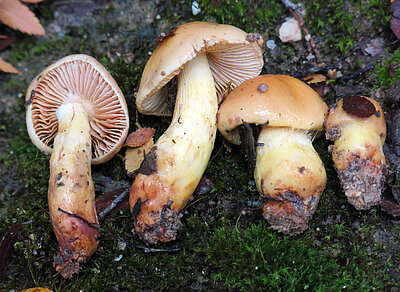New fungus species - new bioactives.
IPB scientists have recently discovered a new species of fungus in Chile's Nahuelbuta National Park. The official species name is Cortinarius steglichii N. Arnold, Palfner, Peintner, Huymann - a name given in honor of the renowned chemist and mushroom expert Prof. Wolfgang Steglich. In 1994, Steglich was a member of the institute's first Scientific Advisory Board and, not only in this position, but also as a competent cooperation partner, he accompanied and shaped the institute's fortunes for many years.
With around 6000 species, the genus Cortinarius, also known as gypsophila, is one of the most species-rich genera in the department of the stand fungi. Its representatives always live in close association with woody plants and are distributed worldwide. Cortinarius steglichii had caught the attention of the experts from Halle on their extensive mushroom excursions through the Chilean mixed forests because its fruiting body showed a striking purple-black color reaction when it was sprinkled with potassium hydroxide solution. This was an important indication that it could be a new species.
This assumption was confirmed in many further analyses. In addition to a precise morphological and microscopic description of the fungus, the scientists also provided a systematic classification of the new species in the realm of fungi. The ingredient that turns black with potassium hydroxide solution turned out to be a previously unknown diterpenoid substance whose chemical structure could be fully elucidated by the fungal experts.
The compound called Steglichon turned out to be a powerful antibiotic against Bacillus subtilis. Due to its strong sensitivity to all kinds of antibiotics, this type of bacillus is used in pharmacology as a test organism to check certain substances or substance mixtures for the presence of antimicrobial agents. This is particularly relevant because Bacillus subtilis, as a gram-positive bacterium, has a cell wall and therefore similar protective barriers as many pathogens, for example anthrax, diphtheria and pneumonia. An antibiotic effect on Bacillus subtilis can therefore give a first hint that the tested substance also has the potential to kill other (pathogenic) gram-positive bacteria. Steglichon and its derivatives could also have such antibacterial potential and are therefore suitable for the research and development of new antibiotics.
The anti-cancer effect of Steglichon is even more remarkable. Using cell cultures, the scientists found that Steglichon even at low doses inhibits the growth of human breast, colon and prostate cancer cell lines and also actively kills the malignant cells. Whether this cytotoxic effect is specific to cancer cells, however, still needs to be determined in further tests. Nevertheless, due to its high activity, further studies on the mode of action of this anti-tumor substance could be worthwhile, the scientists conclude. To date, around 260 species of Cortinarius are known in Chile and Argentina. However, their chemical arsenal of bioactive compounds is largely unexplored so far.
The study was funded as part of the DFG project Posadec.


